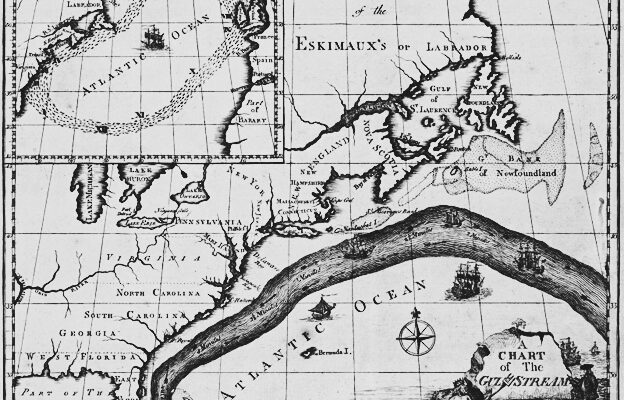There is a river in the ocean: in the severest droughts it never fails, and in the mightiest floods it never overflows; its banks and its bottom are of cold water, while its current is of warm; it takes its rise in the Gulf of Mexico, and empties into the Arctic seas; this mighty river is the Gulf Stream.
Thus, began chapter II of the newly published book Physical Geography of the Sea, and its Meteorology, by Matthew Fontaine Maury, Superintendent of the National Observatory at Washington. The year of publication was 1855.
In 1855, no man of learning was surprised to read of the existence of the Gulf Stream. People had known of its existence for many years. And, in fact, Benjamin Franklin had known of the Gulf Stream during his life, and had actually given this curious “river in the ocean” its name. Mr. Franklin was a man of science, who studied various phenomena such as winds, storms, and the lightning produced by these storms. He was also a statesman who served in various diplomatic capacities in the nations of Europe.
It is no surprise, then, that while in London in the year 1770, Dr. Franklin took a particularly keen interest in a curious dispatch with which he had been presented. The dispatch had been addressed to the Board of Customs in England by the Merchants of Boston requesting that their Falmouth packets be routed to Providence, Rhode Island, rather than their normal routing to Boston. The reason for the request was that, as the Merchants in Boston described in their letter, the packets to Boston were generally a week or more delayed in arriving to port behind the time it took the common traders from London to reach Providence. This report seemed very strange to Dr. Franklin, who knew that London was much further sailing distance than Falmouth, and that the routes taken from both Falmouth and from London out in the open Atlantic were exactly about the same latitudes. Dr. Franklin resolved to look more closely into the matter.
As fate would have it, a distant cousin of Dr. Franklin, Captain Folger, a whaler, happened to be in London during the same time. Dr. Franklin then called on Capt. Folger, consulting with him as to whether the latter knew the reason for this strange report. Assuming the report to be true, what might be the cause, Dr. Franklin inquired. Captain Folger immediately informed his cousin that the report of the Boston Merchants was indeed correct, and, moreover, that there was a perfectly logical explanation; it was that the Rhode Island captains were familiar with the Gulf Stream and its course in the upper latitudes, and thus avoided its strong westerly currents on their voyages back to the United States, whereas those of the London packets were not acquainted with the Gulf Stream and therefore continued in it, fighting its strong currents the entire way to Boston. This was an important discovery, and Dr. Franklin enlisted the services of his seafaring cousin to help him map out the path of this “river in the sea.”
By 1775 the mapping of the Gulf Stream was complete, but Dr. Franklin did not immediately make the map available for publication for two primary reasons: first, recall that in 1775 Great Britain and her independence-minded North American colonies were at the brink of all-out war. Dr. Franklin had no intention of giving the British an advantage in transporting troops and supplies to America by informing their sea captains of their mistaken route into the strong headwaters of the Gulf Stream. Second, discovery of the path of the Gulf Stream was thought by Franklin at the time to be a partial answer to the problem of finding longitude at sea. And so it was, at least in the North Atlantic, for although the Gulf Stream was known by Franklin to shift east and west in longitude throughout the seasons, it was also known by him that its east to west deviation from its longitudinal course was never so much as the average mistake made by ship’s captains in their dead reckonings of their longitude at sea.
When Mr. Harrison began his work designing and building an accurate timepiece suitable for use at sea, he did so under promise by the British government to be rewarded with a handsome sum of money should he succeed in solving the longitude problem that had plagued seafaring men for so many centuries. The sum originally promised was 20,000 British Pounds, the equivalent of roughly four million American dollars. Upon rigorous testing of his Marine Chronometer and its usefulness for correctly determining longitude at sea, Harrison was awarded about half the promised amount, while the remainder was withheld in lieu of discovery by others of equally useful and practicable methods. For some time, therefore, Franklin believed his discovery and mapping of the Gulf Stream might entitle him to the balance of the reward, or at least a part of it. In consideration of all of this, Dr. Franklin did not make the discovery known right away. But by 1790, some years after the war between Great Britain and her American colonies had closed, and just one year following the adoption of the United States Constitution by the several States, Franklin released for publication his map of the Gulf Stream waters.
Of its power and majesty, Maury would further describe this curious “river in the ocean”:
There is in the world no other such majestic flow of waters. Its current is more rapid than the Mississippi or the Amazon, and its volume more than a thousand times greater. Its waters, as far out from the Gulf as the Carolina coasts, are of indigo blue. They are so distinctly marked that their line of junction with the common sea-water may be traced by the eye. Often one half of the vessel may be perceived floating in Gulf Stream water, while the other half is in common water of the sea – so sharp is the line, and such the want of affinity between those waters, and such, too, the reluctance, so to speak, on the part of those of the Gulf Stream to mingle with the littoral waters of the sea.
That the Gulf Stream existed was, in 1855, news to no one of learning, as has been said above. But beyond its mere existence, little more was then known. As Maury describes it then, in the paragraphs of chapter two of his book, he is explaining features of the Gulf Stream that no one had ever before heard or known. No one, for instance, had ever known what was the cause of the Gulf Stream, nor had anyone before Lieutenant Maury attempted to understand its cause. What were the causes that put it in motion? Moreover, what were the causes that kept it in motion? Why is its waters “reluctant to mingle” with the littoral waters surrounding it? What might be the cause or causes that give to the Gulf Stream its easterly deflection once it has reached a certain degree of latitude, turning it from a NNE course, to an easterly one? These and many other questions no one had ever answered satisfactorily, nor had done the necessary scientific work to determine the answers to. That would all change when men like Captain Phinney caught the spirit and recognized the importance of lieutenant Maury’s work.
Lieutenant Maury continues with his description in para. 72, Speculations Concerning the Gulf Stream:
What is the cause of the Gulf Steam has always puzzled philosophers. Many are the theories and numerous the speculations that have been advanced with regard to it. Modern investigations and examinations are beginning to throw some light upon the subject, though all is not yet entirely clear. But they seem to encourage the opinion that this stream, as well as all the constant currents of the sea, is due mainly to constant difference produced by temperature and saltness in the specific gravity of water in certain parts of the ocean. Such difference of specific gravity is inconsistent with aqueous equilibrium, and to maintain this equilibrium these currents are set in motion. The agents which derange equilibrium in the waters of the sea, by altering specific gravity, reach from the equator to the poles, and in their operations they are ceaseless as heat and cold; consequently they call for a system of perpetual currents to undo their perpetual work.
No man alive or who has ever lived knows, of course, how long the Gulf Stream has existed beyond pure speculation, but one thing is certain: for as long as the earth has existed in its current state – with its distance from the sun, its annual orbit of 365 days, the rotation on its axis of once every 24 hrs., the degree of its tilt relative to the plane of its orbit, the situation of the continents and the oceans relative to one another, along with its atmosphere – however long the earth has existed in its current state, it is impossible that the Gulf Stream has ever not existed during that time. Although Columbus sailed south of the Gulf Stream in his quest to discover a new route to the East Indies, we know that the Gulf Stream nevertheless existed in 1492 by the fact that he and his crews sailed through what we now call the Sargasso Sea, which itself would not exist in the absence of the Gulf Stream to create the massive Atlantic whirlpool responsible for its existence.
It is no mere coincidence or chance occurrence that the temperature of the waters of the Gulf Stream is upwards of 88 degrees fahrenheit as they leave the Gulf of Mexico to traverse the parallels in their journey towards the arctic latitudes. A simple glimpse of the map reveals in an instant that the center of the Gulf of Mexico lies on the Tropic of Cancer, where heat ceaselessly accumulates during all seasons as in a caldron on an open flame.
Upon Lieutenant Maury’s scientific investigations, the waters of the Gulf Stream were found to contain a greater proportion of salt than the littoral waters surrounding them, or the common sea water. This “greater saltness” alters the specific gravity of the of Gulf Stream waters, making them heavier than the surrounding waters. It is a commonly understood law of physics that that which is heavier sinks below that which is lighter in the absence of some other force to counteract gravity. Applying this rule, the heavier waters of the Gulf Stream should naturally sink below the lighter waters beneath them. But there is another power at work in the waters of the Gulf Stream that counteracts that of weight. It is the accumulation of heat. When something gets warmer it expands. The expansion of the Gulf waters due to their warmth causes them to become lighter than the condensed colder littoral waters surrounding them. Therefore, the overheated Gulf Stream waters continue near to the surface so long as they retain their heat relative to the surrounding waters. And they retain a large amount of their heat for great distances in their ceaseless course.
The log books and journals of old sailing ships abound with stories of winter crossings of the North Atlantic in which ships encountered severe winter storms and frigid conditions, dangerously turning them into buckets of ice and snow on the brink of being sunk due to the added weight, and their crews into veritable snowmen. But whereupon these “ice buckets” had the good fortune of finding their way to and taking refuge in the balmy waters of the Gulf Stream, the ice would quickly melt away as the sailors took their turns bathing in its tepid waters, warming their bodies and reinvigorating their chilled and stiffened limbs.







https://ncrenegade.com/
http://nicholasstixuncensored.blogspot.com/
Maybe every southerner should have one of those ‘time box’ planners. It helps us with our ‘priorities.’
Please do elaborate, sir.
All: I see that I failed to provide my usual parenthetical note explaining that the article is actually a chapter in the Maury book. Namely, chapter XV. Now you know.